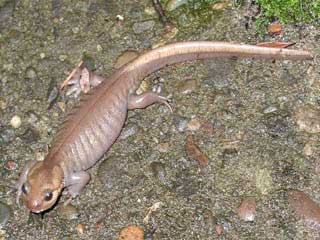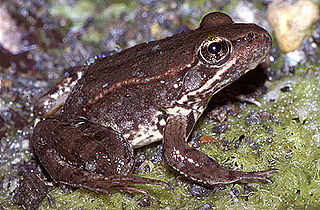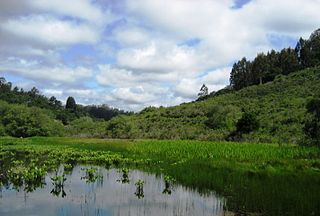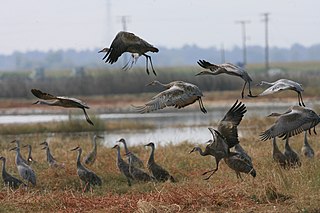
The tiger salamander is a species of mole salamander and one of the largest terrestrial salamanders in North America.

The spotted salamander or yellow-spotted salamander is a mole salamander common in eastern United States and Canada. It is the state amphibian of Ohio and South Carolina. The species ranges from Nova Scotia, to Lake Superior, to southern Georgia and Texas. Its embryos have been found to have symbiotic algae living in and around them, the only known example of vertebrate cells hosting an endosymbiont microbe.

The California tiger salamander is a vulnerable amphibian native to California. It is a mole salamander. Previously considered to be a subspecies of the tiger salamander, the California tiger salamander was recently designated a separate species again. The California tiger salamander distinct population segment (DPS) in Sonoma County and the Santa Barbara County DPS are listed as federally endangered, while the Central California DPS is listed as federally threatened. The Sonoma County, south San Joaquin, and the Santa Barbara County DPS have diverged from the rest of the California tiger salamander populations for over one million years, since the Pleistocene and they may warrant status as separate species.

Vernal pools, also called vernal ponds or ephemeral pools, are seasonal pools of water that provide habitat for distinctive plants and animals. They are considered to be a distinctive type of wetland usually devoid of fish, and thus allow the safe development of natal amphibian and insect species unable to withstand competition or predation by fish. Certain tropical fish lineages have however adapted to this habitat specifically.

The Jefferson salamander is a mole salamander native to the northeastern United States, southern and central Ontario, and southwestern Quebec. It was named after Jefferson College in Pennsylvania.

The blue-spotted salamander is a mole salamander native to the Great Lakes states and northeastern United States, and parts of Ontario and Quebec in Canada. Their range is known to extend to James Bay to the north, and southeastern Manitoba to the west.

The frosted flatwoods salamander is an endangered salamander species native to the Southeastern United States.

The northwestern salamander is a species of mole salamander that inhabits the northwest Pacific coast of North America. These fairly large salamanders grow to 8.7 in (220 mm) in length. It is found from southeastern Alaska on May Island, through Washington and Oregon south to the mouth of the Gualala River, Sonoma County, California. It occurs from sea level to the timberline, but not east of the Cascade Divide. Its range includes Vancouver Island in British Columbia and The San Juan Islands, Cypress, Whidbey, Bainbridge, and Vashon Islands in Washington.

The long-toed salamander is a mole salamander in the family Ambystomatidae. This species, typically 4.1–8.9 cm (1.6–3.5 in) long when mature, is characterized by its mottled black, brown, and yellow pigmentation, and its long outer fourth toe on the hind limbs. Analysis of fossil records, genetics, and biogeography suggest A. macrodactylum and A. laterale are descended from a common ancestor that gained access to the western Cordillera with the loss of the mid-continental seaway toward the Paleocene.

The California red-legged frog is a species of frog found in California (USA) and northern Baja California (Mexico). It was formerly considered a subspecies of the northern red-legged frog. The frog is an IUCN near-threatened species as of 2021, has a NatureServe conservation status of Imperiled as of 2015, and is a federally listed threatened species of the United States that is protected by law.

Ambystoma talpoideum, the mole salamander, is a species of salamander found in much of the eastern and central United States, from Florida to Texas, north to Illinois, east to Kentucky, with isolated populations in Virginia and Indiana. Older sources often refer to this species as the tadpole salamander because some individuals remain in a neotenic state. This salamander lives among the leaf litter on the forest floor, migrating to ponds to breed.

The northern red-legged frog is a species of amphibian whose range is the coastal region stretching from southwest British Columbia to southern Mendocino County in Northern California, and is protected in Oregon and California. As a member of the genus Rana, this species is considered a true frog, with characteristic smooth skin and a narrow waist. This frog requires still waters for breeding, and is rarely found at any great distance from its breeding ponds or marshes.

The California giant salamander is a species of salamander in the family Ambystomatidae. Dicamptodon ensatus is endemic to California, in the western United States. The species once additionally included individuals now belonging to the species D. aterrimus and D. tenebrosus, under the common name Pacific giant salamander, which now refers to the genus and family.
The silvery salamander is a hybrid species of mole salamander from the United States of America and Canada. It is usually between 5.5 – 7.75 in long and is slender with many small silvery-blue spots on its back and sides. It is brownish grey and the area around its vent is grey. This unisexual Ambystoma hybrid species, has been grouped with other unisexual ambystomatids that takes genetic material from Jefferson salamander, streamside salamander, small-mouthed salamander, tiger salamander and the blue-spotted salamander.
The reticulated flatwoods salamander is a species of mole salamander, an amphibian in the family Ambystomatidae. The species is native to a small portion of the southeastern coastal plain of the United States in the western panhandle of Florida and extreme southwestern Georgia. The species once occurred in portions of southern Alabama but is now considered extirpated there. Its ecology and life history are nearly identical to its sister species, the frosted flatwoods salamander. A. bishopi inhabits seasonally wet pine flatwoods and pine savannas west of the Apalachicola River-Flint River system. The fire ecology of longleaf pine savannas is well-known, but there is less information on natural fire frequencies of wetland habitats in this region. Like the frosted flatwoods salamander, the reticulated flatwoods salamander breeds in ephemeral wetlands with extensive emergent vegetation, probably maintained by summer fires. Wetlands overgrown with woody shrubs are less likely to support breeding populations.

The Ellicott Slough National Wildlife Refuge is a United States National Wildlife Refuge located in the northern part of the Monterey Bay area of California.

The Merced National Wildlife Refuge encompasses 10,262 acres (41.53 km2) of wetlands, native grasslands, vernal pools, and riparian areas in California. It was established in 1951 under the Lea Act to attract wintering waterfowl from adjacent farmland where their foraging was causing crop damage. In the last few decades, changes in agricultural practices and refuge management have reduced these wildlife/crop issues.

Carneros Creek is a westward flowing stream and is the primary source of freshwater flowing into Elkhorn Slough. The Carneros Creek official mainstem is 9.8 miles (15.8 km) long. Its source is in the northern Gabilan Range along Highway 101/156. After it waters transit Elkhorn Slough, the historic mouth of the Salinas River, Carneros Creek empties into Monterey Bay at Moss Landing, California.

There are 14 species of amphibians and 5 species of reptiles known to occur in Mount Rainier National Park.


















